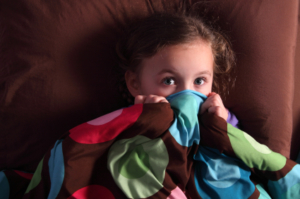As parents one of the things you can be almost certain to face as your children age is the experience of fear followed by avoidance. Children (and adults for that matter) often end up in situations where they become quite fearful of something and, thanks to the mind’s negativity bias (e.g.,
What do we do? Well, we try to extinguish the fear, of course. However, most of the work on fear extinction is based on extinction after conditioning of fear (e.g., [3][4][5]), but what about before they are consolidated? What about us parents who see the situation happen and want to avoid this type of fearful response in the first place? Is there help for us?
Research suggests that it takes two periods of synthesis for fear-motivated learning to actually consolidate[6], one right at the time of trauma and a second period three to six hours later. This means there are opportunities to inhibit this full consolidation of the fearful memory, if only we take advantage of them. Getting back on the proverbial horse is likely one of the best ways because the memory becomes flooded with similar memories without trauma, but what if a child is resistant? Is forcing them through tears and more trauma helpful? Those of you who have tried this will know that it really isn’t.
So what can you do? Let me start with a short anecdote:
My daughter was in a pool with two friends, who were much more competent swimmers than she. She had her “swimmy” on (waterwings with the waist floatation area in the front, buckled at the back, see here) and her and one of her older friends were on a raft-type thing. She tickled him, he fell over, and the whole thing flipped over with her going under. Now, she currently hates going under water as she hasn’t mastered holding her breath so she ends up drinking lots of water. She floated back up, terrified, and I pulled her out of the water. Let me be clear, I was surprised, but not panicked. I am aware how our reactions can cause fear in our children and I always wait for her response (well, almost always, sometimes my own fear does get in the way, but this wasn’t one of those times). I pulled her out and she was ready to not go in that water again. So what did I do? Well, I did what I’m about to describe to you as a means to help avoid the fear that comes from traumatic events, namely repeated narrative exposure.
In therapy, if someone suffers acute trauma or PTSD, one of the first things that’s done is narrative exposure coupled with various other types of exposure (you can’t repeat the actual event, but you can expose the individual to situations similar to that they endured without the negative outcome, or so you hope). The patient writes out the situation (first person, present tense) and then the patient reads it aloud (both with the therapist and alone) or records it and listens to it all the while visualizing the events as they unfold. The main point is to desensitize, but in the case of children who have just experienced a trauma, talking it over – even past tense – allows for them to process what happened in a more objective and neutral way, in essence reframing the event. Importantly, focus must be paid on all the emotions surrounding the event.
With my daughter, I had to be the one telling the story and I had to take her away from all the action down by the pool so we went to a bathroom where it was quiet and we could be alone. I started with her getting on the raft with her friend, how happy she was, and then her tickling her friend, again with how she was laughing and playing. Then how he fell over from the tickling and how the raft flipped over. “When it flipped over, were you feeling scared?” She starts crying all over again. “Yes!” “But then, because you had your swimmy on, it brought you back up – you floated to the top of the water again.” She’s crying but listening. “Then you called for mommy and what did I do?” “You got me out.” “Right.”
The first time through I can tell that the idea that her swimmy “floated her” (as she puts it later) to the top is new to her. In her fear and panic, she hadn’t considered that and I can tell her brain is blending that information in to her memory. This is how I know we’re starting to reframe the event in a positive way. I repeat the story, again with a focus on emotions, but trying to get her to fill in more than I do this time around. The second time through, she still cries, but a bit less. The third time through she has an epiphany, “Mommy! When I was under water, I held my breath! I didn’t drink water!” “Wow – does that make you happy?” “Yes!” Suddenly she’s starting to see the positives too. By the fifth, and last, time, she’s no longer crying, she’s happy about how her swimmy floated her up and how she held her breath. At this point, she’s ready to go back downstairs and into the pool again. She accepts she was afraid at the moment she went under, but sees how the rest of the events played out that provided her with safety and security after. In short, she has reframed the event to one that allows her to move forward while accepting how she felt in the moment.
Had I forced her back in, she would have freaked out even more. Had I let her walk away, she would have developed a fear that would have stayed with her for ages and we would have fought that like mad later. By sitting with her and doing exposure immediately, when the three to six hour window came up whereby the fear would be consolidated, there was no fear to consolidate. The event, or rather the memory of the event, has changed. Now, I will be the first to acknowledge that this type of immediate intervention isn’t always possible. Sometimes the trauma is too serious (e.g., a car accident), or you the parent are traumatized too, or you may not even be there with your child. What then?
Previous research on fear extinction always believed the memory was set in stone once it consolidated and that only exposure could help and yet exposure therapy doesn’t always work for those with long-lasting trauma. Luckily, Dr. Karim Nader of McGill University has discovered that this isn’t exactly how memory works (for a great discussion of his work and the effects for long-term memory, see here). Importantly, he found that fearful memories are not just stored once; rather, every time they are recollected they are reconsolidated using the same protein synthesis (e.g. [7]). This means that by reactivating the memory and working to change it, it can be stored differently than before. In short, the fearful memory can slowly be reframed to one that is, well, not quite as scary.
As I previously mentioned, exposure therapy doesn’t always work. The primary reason is that context changes and fear returns, even after extinction training. One of the problems with traditional extinction training has been that the initial fearful memory is not activated prior to extinction training. A small thing, yet critical given the information we now have on reconsolidation of fearful memories. Without the activation of the fearful memory there is no way in which we can alter it prior to reconsolidation. So what if your child is showing fearful responses to something that happened a long time ago?
Do the same thing but you must activate the memory first by talking about that initial memory with your child and having him/her share what happened. This means if you don’t know the initial fearful event, then you may have trouble truly reconsolidating the memory to one that is not fearful, especially if your child isn’t that verbal, but you can try your best and likely have some success reframing. Going forward, it also means you may want to make sure you know details of any event that causes your child some trauma or fear, especially if you aren’t there. Exposure therapy can take more than one time and yet if you don’t know the details it can become very difficult to work with a child whose memory may not be as reliable. However, I hope this also means you can take comfort in the fact that you have the ability to help change your child’s fear without force and without waiting it out. In fact, this may be one of the healthiest ways to help your child face fears







Truly fascinating. Your story combined with the research is very compelling.
Is this the only thing that would work with PTSD? I suffered birth trauma and subsequent PTSD but then realised my “fear” of dentistry from my childhood was actually undiagnosed PTSD (making me more prone to it in future, hence I developed it after my traumatic birth). I don’t think there’s any way I would want to reactivate those horrible experiences from childhood, is there another way? I’m dealing with the birth trauma but I honestly cannot imagine dealing with the other trauma, it was far worse and has been festering for over 20 years.
I doubt this is the ONLY thing that would work, but you’d have to talk to a therapist about your unique circumstance. Exposure alone can work, but you can’t really expose yourself again to things like childbirth and exposure is still the main form of treatment. I think reactivation and reframing is the way to go – but if you are truly fearful of facing them, I would look to getting someone there with you to help talk it through.
Hi Tracy, this is the first time I am writing on a forum. I just love love reading all your articles. They are presented very clearly and backed up scientific research.
I wish I had read this about 4 months ago! My son, who just turned 4, was going to preschool. One day we go in, and it’s picture day, the photographer is there, and they’re doing the group picture, and the photographer is trying to make the kids laugh. But it’s really loud, and for my son, I imagine unexpected, plus the unfamiliar photographer… He got scared, and wanted to go home… Now he does not like school anymore, and doesn’t want to go back. So I didn’t make him. Now I’m wondering if I did the right thing. Plus I think we lost our spot at the school until the fall. I know he’s still young, but I struggle with anxiety and “shyness” myself, so I don’t want to teach him to just avoid scary social situations…